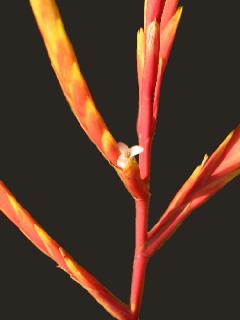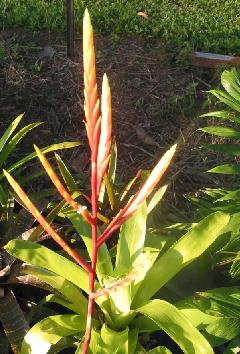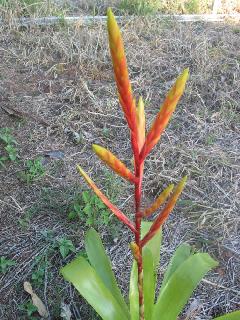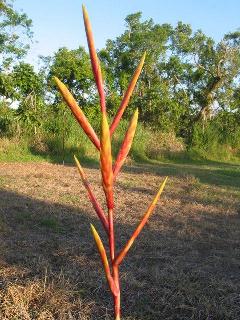



References:
Vriesea rubra (Ruiz & Pavon) Beer, Bromel. 98. 1857.
Tillandsia rubra Ruiz & Pavon, Fl. Peruv. 3: 40, pl. 266. 1802.
Vriesea albiflora Ule, Verh. Bot. Brandenb. 48: 141. 1907. Type. Rio Jurua-Mirim, Acre, Brazil, Ule 5615 (MG, F photo), Jun 1901.
Tillandsia rhododactyla Mez, Repert. Sp. Nov. 16: 76. 1919. Type. Barilla River, Northwest District, Guyana, Jenman 7071 (BRG, GH photo) Mar 1896.
Desc from S&D
Plant flowering over 1 m high.
Leaves 6 dm long;
Blades ligulate, 7 cm wide, flat, rounded and apiculate, subglabrous.
Scape erect, stout;
Scape-bracts imbricate, elliptic, acute.
Inflorescence laxly bipinnate;
Primary bracts lanceolate, much shorter than the spikes;
Spikes suberect, linear, 25 cm long, 2-3 cm broad, complanate, prophyllate.
Floral bracts imbricate, lanceolate, nearly straight, 25 mm long, equaling the sepals, carinate, glabrous, even.
Sepals narrowly elliptic, acute, coriaceous;
Petals ligulate, bearing 2 largely adnate scales, white;
Stamens and pistil included.
Capsule equaling the sepals.
Type. Ruiz & Pavon s n (holotype MA, F photo), Tarma, ]unin, Peru.
DISTRIBUTION. Epiphytic and terrestrial in forest, 50-800 m alt, Colombia to Trinidad, Peru and Amazonian Brazil.
COLOMBIA. NORTE DE SANTANDER: Bellavista, 15 Sep 1946, Foster 1694 (GH). META: Cano Yerly, Sierra de la Macarena, 24 Nov 1949, Philipson, 1drobo & Fernandez 1551 (BM, US). CAQUETA: Rio Guyas, on Rio Caguoin, 20 Apr 1953,Romero Castarieda 4018 (COL, US); La Tagua to Puerto Boy, Rio Caquetoi, 9 May 1953, Romero Castarieda 4219 (COL, US). VENEZUELA: DELTA AMACURO: San Victor, Rio Allacuro, Sierra Illataca, 4 Nov 1960, Steyermark 87321-A (NV). ZULIA: Rio Vasa, Machiques, Sierra de Perija, Aug 1967 , Steyermark & Fernandez 99748 (US, VEN). BOLIVAR: Aparuma, Kavanayen Lasser 1944 (VEN); Rio Apacara, Uriman, 16 Aug 1954, Bernardi 1435 (MER, NY); Puerta Lema to Sierra de Lema, Aug 1961, Steyermark 89667 (US, VEN); Rio Paramichi, 4° 2-12' N, 63° 1-5' W, Jan 1962, Steyermark 90771 (US, VEN). TRINIDAD. Tamana, 1868, collector (?) in part (TRIN 2008); 1915, Broadway 7806 (NY, TRIN); Pittendrigh 1232 (US); 1303 (TRIN); Platanal, 1942, Pittendrigh 1110 (US); Tamana to Platanal, Pittendrigh 1522 (TRIN); Tabaquite, 2 Aug 1955, Aitken s n (TRIN, US). GUY ANA. RUPUNUNI: Dadanawa, Rupununi River, 2° 45' N, Jul1 922, Cruz 1709 (F, GH, NY). ECUADOR. Without exact locality: 6 Oct 1964, L. Moore BM-70 (US). PERU. Huanuco: Rio Huallaga Canyon below Rio Santo Domingo, Jun 1923, Macbride 4265 (F, GH); Tingo Maria, 21 Jul 1940, Asplund 12412 (S, US); 1950, Allard 21638 (US).
Description by Gouda in Flora of the Guianas 1987
Plant acaulescent, flowering to over 1m long, with a large, spreading, 50-60 cm tall rosette of many pale-green leaves.
Leaves thin-coriaceous, 50- 70 cm long, much exceeded by the inflorescence;
Sheaths distinct, contracted into the blades, elliptic, inflated-convex, 12-17 x 7.5-8.5 cm, with broad and pale membranaceous margins, (sub-)densely appressed-lepidote on both sides, pale-brown to castaneous at the base;
Blades arching, ligulate, 40-55 x 5.5-6.5 cm rounded and apiculate, obscurely lepidote or glabrescent, pale-green.
Inflorescence erect, laxly or subdensely bipinnate of 3-10, polystichously arranged spikes, or sometimes tripinnate, then the lower branches digitate of two spikes, glabrous; Scape 30-85 cm long, 7-10 mm in diam., glabrous, coral-red, nearly all over covered by bracts;
Scape bracts erect, densely imbricate, chartaceous, ovate (-oblong), apiculate, exceeding the internodes, but often so narrow as to expose the scape in part, sparsely and minutely appressed-lepidote at least at the apex;
Axis exposed, more or less elongate, slightly flexuous, angled or terete;
Primary bracts as the upper scape bracts, spreading with the spikes, much exceeding the short peduncle, the upper ones not much larger than the floral bracts, obscurely lepidote at the base or glabrous, red;
peduncle suberect or spreading, 1-2(-3) cm long, only bearing a prophyl-like bract (halfway);
Spikes linear-lanceolate, strongly complanate, 9-26 x 1.5-2 cm, acutish, densely and distichously 10-30-flowered, with one sterile bract at the apex; rachis for most part exposed (when dry), flexuous, sharply angled, rugose, deep-red;
Floral bracts erect, imbricate, but so narrow as to expose the rachis, fleshy coriaceous, with slightly veined surface, ovate-oblong, 2.5-2.8 cm long, 2-4 times as long as the internodes, about equaling the sepals, apiculate or acutish, finely carinate in upper half, glabrous, yellow-green and tinged with red in lower part.
Flowers contiguous, (sub-)sessile; receptacle narrowly obconic, ca. 2 mm long, bicarinate;
Sepals coriaceous, with faintly veined surface at the base only when dry, lanceolate, 2.2-2.4 cm long, acute, evenly short-connate, posterior ones somewhat thickened at the base (not distinctly carinate), slightly incurved at the extreme apex, glabrous;
Petals ligulate, over 3 cm long, white, bearing 21argely adnate ligules at the base; ligules ca. 1.1 cm long, free lobes elliptic, ca. 2 mm long, entire or nearly so, obtuse;
Stamens included, all equal in length, exceeding the pistil by half of the anthers, filaments adnate to the petals, free part subterete, anthers basifixed, linear-sagittate, 6- 7 mm long (free basal-lobes ca. 1 mm long); ovary slenderly ovoid, attenuate from near the base, then abruptly contracted into the slender style, stigmas short-sublinear, flat.
Capsule very slenderly ovoid, equaling the sepals, ca. 0.5 cm in diam., attenuate, then abruptly short-beaked.
Distribution: Colombia to Trinidad, Peru and Amazonian Brazil. Epiphytic and terrestrial in forest, from near sea level to 2300 m alt. 9 collections studied from E. Bolivar, Venezuela and Guyana: Upper Rupunini River, near Dadanawa, de la Cruz 1709 (US); Koriabo, Barima River, NW. distr., Charles 10 (K); Essequibo River, Moraballi Creek near Bartica, Sandwith 74; 504 (K).
Culture and use: This species is suitable for larger greenhouses only, it is easily grown and flowers regularly.